NBB 201 Exam 2
1/72
There's no tags or description
Looks like no tags are added yet.
Name | Mastery | Learn | Test | Matching | Spaced |
|---|
No study sessions yet.
73 Terms
What is animal behavior?
how individuals respond to internal and external stimuli - social, structural, physiological
What is ethology?
study of character
subfield of biology
What role does Darwin play on behavioral studies?
foundation of modern study
said that similar animals exhibit similar ritualized behaviors as well as morphologies, so instincts are also subject to natural selection
argued evolutionary continuity to emotions
first to say animals also have emotions
What is evolutionary continuity of emotions? Give an example
the argument that human emotions are derived from/rooted in animal emotions
ex) hair raising when scared
ex) someone baring their teeth when feeling extreme rage
Who are the 3 early ethologists we learned about and what approach did they have?
Niko Tinbergen
Karl von Frisch
Konrad Lorenz
the watching and wondering approach
Explain Tinbergen’s studies and what he learned from them
studies of instinctual behaviors
learned fixed action patterns, innate releasing mechanisms, sign stimulus, and supernormal stimuli
Explain Tinbergen’s experiment with baby gulls
the baby gulls peck at a red dot on their parents beak to get food so he presented baby gulls with a normal model head, a model head with no eyes but with a red dot, and a model head with eyes but no red dot, and a red pencil.
the baby gulls pecked the most at the red pencil - which was the supernormal stimulus (more intense than normal)
Explain sign stimulus, innate releasing mechanisms, fixed action patterns, and supernormal stimuli? Give example of baby gull
fixed action pattern = when a trigger sets off a set behavior pattern in an animal that goes through to completion even if the situation changes
the baby gulls pecking when they see red
sign stimulus = what triggers the fixed action pattern
the color red for the gulls
innate releasing mechanisms = the neural network that causes fixed action pattern
supernormal stimulus = trigger that is more exaggerated than what is normal
the red pencil for the gulls
What are proximate vs ultimate explanations of behavior?
proximate = in terms of immediate current factors, relevant & measurable at a current time or during development
answers what and how
ultimate = explanation in terms of process and force of evolution
answers why
What are Tinbergen’s 4 questions? How are they integrated?
ABCDEF
Animal Behavior
Proximate:
Causation = sensory-motor mechanisms
Development = change over lifetime
Ultimate:
Evolution
Function = survival value
evolution → development → mechanism → BEHAVIOR → function
What did von Frisch study and what did he learn?
he studied bees
found bees have color vision
by keeping wells of grey colored nectar with one bright blue one - bees went for blue one showing they see color
bee waggle dance
angle shows hivemates what direction food is
duration of dance shows how far it is
What did Kondrad Lorenz study?
study of imprinting
baby ducks hatch and whoever they see first they think is there mother who they follower around
What are the 5 factors in which Ethology and Behaviorism differ?
Ethology
European
based in biology
studied birds, fish, insects, and later primates
based on FIELD observations and experiments
study instinctive behaviors like parenting or mating
Behaviorism
North American
based in psychology
studied rats, pigeons, dogs, and primates
based on tight LAB control of variables
study learned behavior like foraging
What did B.F. Skinner study and claim?
rats with the lever for food
claimed behavior is ENTIRELY result of experience
What is behaviorism? What are two laws?
claims all behaviors are accounted for with a few laws
Equipotentiality - claim that any two stimuli can be associated with each other regardless of their nature
Pavlov’s Law of Association
classical and operant conditioning
the dog experiment
Little consideration of evolution or of natural behavior
Who is Margaret Altmann?
one of first women in psychobiology, ethology, and animal husbandry fields
modern naturalist who studied large animals in natural habitats
studied endocrine system and sexual cycle in sows and cattle
Who is Charles Henry Turner?
first person to discover insects can hear and alter behavior based on previous experience
showed insects were capable of learning
published paper that honeybees can see color 4 years before Frisch did
What pitfalls should be avoided in understanding behavior?
should not assume complexity
parsimony is good = assume simplest explanation
should not ignore umwelt
umwelt = perceptual world in which an organism exists and acts as a subject
animals have diff sensory systems than us so we should be mindful of how they perceive world when putting them through experiments
ex) birds see in UV so they each other has more colorful
peacock mantis shrimp have crazy specialized eyes
dogs have insane smelling abilities
should not ignore natural proclivities/capabilities
should not have stasis - use new methods
Explain behavioral evolution and give examples
works same way as evolution
variation in behavior occurs in a population
only individuals with advantageous evolution pass it on to next gen
population evolves
imp to note that virtually every behavior is shaped by genes acting in sequence/coordination to produce that behavior
a behavioral trait is controlled for by many genes
ex) C. elegans (nematode)
only has 302 neurons, but 100 are involved in locomotion and 18 involved in response to touch
fox domestication example
Discuss fox domestication in terms of behavioral evolution
Russian Fox experiment is a proxy for dog domestication processes
we usually think of evolution as happening over thousands of years only but these foxes changed in less than 50 years
selection was for tameness but also because many genes control behavior, many other traits also got affected
changes in color
changes in skull shape/morphology
tail wagging
reduced fear responses to new objects, people
correlated traits maintain variation
Discuss behavioral epigenetics, its mechanisms, and give an example
behavioral epigenetics = interaction of genes and environment in terms of how they affect behavior
“how nurture shapes nature”
epigenetics is a heritable change in gene expression not actual gene sequence
change in phenotype not genotype
influenced by experience and environment
mechanisms:
DNA methylation - adding methyl groups turns a gene off
Histone modification - changes way DNA is packaged which affects gene expression
ex) anxious rats
good mom → pups with low anxiety
bad mom → pups with high anxiety
but when cross fostered, pups from bad mom had low anxiety when with good mom and pups from good mom still had low anxiety when with bad mom bc some of the genetic factors from good mom were protective
licking and grooming by mother resulted in pups with different DNA methylation patterns in stress receptor gene in brain
What is a group? How is that definition different from territory and home range?
number of animals which remain together in or separate from a larger unit and mostly interact with each other
different from:
territory - where social group lives
defended piece of land
home range - portion of territory where one spends most of their time
What are the 4 conceptual factors of a social system?
social organization
social structure
mating system
care system
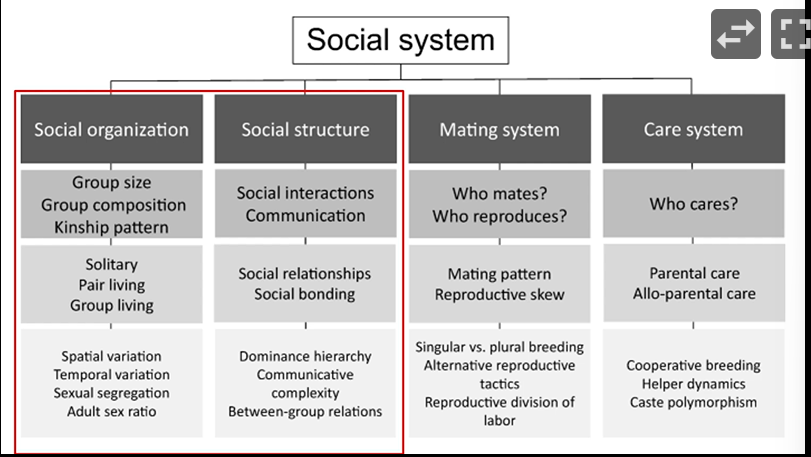
What are the 5 general types of social groups?
solitary
pair-bonded
3 group living types:
multi-male, one female
one male, multi-female
multi male, multi female
What are solitary primates? Give an 3 examples
examples: aye-ayes, tarsiers, orangutans (kind of a rule-breaker)
significantly correlated with nocturnal activity
often small body size - not always
active hours are spent alone - forage alone
females usually have kids with them tho
they gather only for mating or sleeping (provides safety)
individuals’ homerange overlaps with members of the same and opposite sex
What are paired primates? Give 3 examples
ex) owl monkeys, gibbons, and siamangs
pair-living evolved independently in all major primate radiations
it is rarest type of social organization
related to parental care and infanticide avoidance
What are one female multi male primate groups?
ex) pygmy marmoset
also very rare
thought is that these groups start off as a breeding pair and then a second adult male may join and mate with female
thought to be related to the fact that because pygmy marmosets tend to have twins a lot, extra paternal care is a selective force for them
What are one male multi female primate groups? Give an example
ex) gorillas
typically one silverback gorilla (single breeding male) and many females
both males and females disperse at sexual maturity
but - about 30% of mountain gorilla groups in Rwanda have multiple silverbacks; even though this is such a classic primate group organization, it seems to be fairly flexible
debate why this is case. one thought is that bc of habitat loss, the male gorillas dont have enough area to leave and start their own group that is why they are living like this. even in multi silverback gorillas, only one breeds
What are fission fusion multi-male multi-female primate groups?
ex) humans, chimps
belong to a main group
regularly fission into small subgroups or fuse into large subgroups
grouping based on a combo of food availability, female estrus status, intergroup interactions, “friendships”
What are multi-level societies in multi-m multi f primate groups? Give 2 examples
ex) geladas, hamadrya baboons
geladas are grass eaters - cow monkeys
shuffle eating
only found in Ethiopian highlands
hierarchical groups - many different levels of grouping with final level including hundreds of primates
Define socioecology and give the 2 important questions we ask in it
deals with social interactions among members of a species and how that interacts with their environment
Why do animals form groups?
Why do animals form the groups they do?
What are pressures that organisms want to avoid and what are some they want to find?
avoid:
predators, aggression, disease
find:
food and mates
Explain the relationship between predation pressure and living in groups?
living in a group reduces predation pressure because it helps with 3 Ds:
deter, detect, dilute predators
What are 3 benefits of forming groups?
reduces predation pressure
deter, detect, dilute
split offspring care - caring for offsprings becomes easy
group defense - can defend a territory in a group
What are 4 costs of forming groups?
competition for resources
social stress
disease
infanticide
Why do animals form groups?
sociality is favored when
predation is high
group defense is beneficial
group size is constrained when
high resource competition
disease
What is the socioecological model?
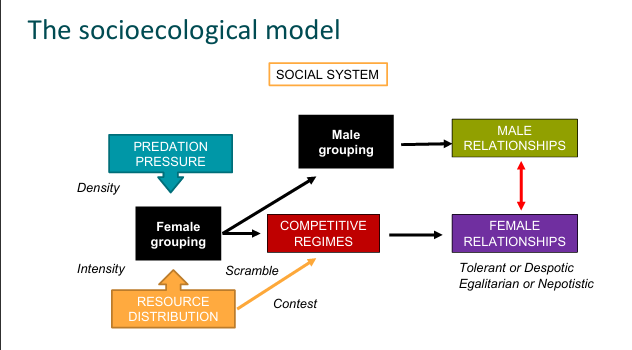
What are limitations of the socioecological model?
"all models are wrong, some are useful” - G. Box
breaks/exceptions to model, highlights that resource comp is not what it appears
models cannot factor in ALL social aspects → social factors, infanticide risk, parental care, disease
not every habitat represents same adaptive problem
differences in cognitive ability → alter social relationships and foraging efficiency
simplifies male and female roles → males also help in resource defense and females are more than just a resource for males bc they also help in resource defense
What is an exception to the socioecological model?
folivore paradox
black and white colobus and mountain gorillas are folivores but still live in pretty small groups even though leaves are a dispersed resource and should inc group size
they still have predators so that should also inc group size
why do they live in small groups?
infanticide risk - larger groups of F may attract outside M
best quality leaves may get depleted - low level scramble comp
larger group may be impacted by aggressive social dynamics
What is the difference between natural selection and sexual selection?
natural selection → differential survival
sexual selection → differential reproduction
What is differential investment for females vs males
differential investment is also reproductive potential which is basically how much can females vs males contribute to gene pool and how that impacts their sexual selection preferences
females
tend to invest more in offspring
reproductive success limited by quality of mate
have long gestation periods and lactation periods
once pregnant, taken out of the mating pool for a while
males
invest less in offspring
reproductive success limited by quantity of mate
What are the major categories of sexual selection?
intrasexual selection
mate competition; between members of one sex competing for mates
direct benefits:
females, fertilizations
indirect benefits:
resources, protection/care
intersexual selection
mate choice; typically females choose mates
material benefits:
parental care, other resoruce
indirect benefits:
healthy mate, good genes
Explain 2 male reproductive strategies for direct benefits
1) compete with other males for mating opportunities (direct benefits)
strong selection for traits that help males fights win other males
ex) big canines on baboon and gorillas just being big
leads to sexual dimorphism
but fights are costly - selection should select for way to compete without death or injury → dominance hierarchies
dominance hierarchies set up priority of access model
males might compete for status by doing big displays of dominance and that gives them power to have priority of access to females
2) compete for fertilizations - sperm competition
testes vs body weight size
monogamous primates had lower testes vs body weight measurement when compared to polygamy and multi-m multi-f group monkeys
Explain 2 male reproductive strategies for indirect benefits
indirect benefits = not competing directly mating but competing for something else that would attract a female
1) compete for territories/resources
2) invest in parental care
Explain female pre-copulatory reproductive strategies in material benefits vs indirect benefits
females look for a good quality mate
material benefits - who can give her and her kids good material resources
look for parental care or other physical resources like land/food
indirect benefits - who can give her and her kids good genes/health
healthy mate - in the current times, make sure he is not sick so she or her kids don’t catch something from him
good genes - choose someone with good genes to think ahead for the next generation getting good genes
sexy sons - somewhere in evolution of female for that species, a preference for an arbitrary trait arises which has no link to good genes or health. This could be like long tail feathers or something. Females will select mates with that trait so that her sons will have the trait and her daughters will have preference for it
AKA runaway selection
How can a female assess genetic quality?
good genes hypothesis rests on idea that traits are condition dependent
so the males have be in good condition and/or have high quality genes to even exhibit these external traits
ex) Mandrill coloration; bright blue color equal more testosterone and dominance rank
Explain why good genes are not universal high quality
good genes can vary individually based on either compatibility or complementarity
ex) rodent females smell to discriminate and choose mates based on MHC (major histocompatibility complex - immune system is strong and varied) that is different from their own to give offspring diverse genes
Explain sexually selected traits in terms of good genes vs sexy sons
good genes
condition dependent → other traits indicate that the individual has good genes
ex) Mandrill monkeys with the blue marks indicating they have higher testosterone
sexy sons - aka runaway selection
NOT condition dependent
some point in evolution, female preference for trait randomly evolves
males with that trait mates more
sons have that trait, daughters have the preference
Explain the relationship between natural selection and sexual selection
They balance each other because Darwinian fitness has two components: survival and reproduction.
It is possible that they are sometimes at odds with each other because it is possible that female preference of a trait causes it to eventually become so exaggerated in a species, that it is actually past the optimal intensity of that trait and has started to become disadvantageous for the animal.
ex) birds and tail length.
ex) Irish Elk with the huge antlers
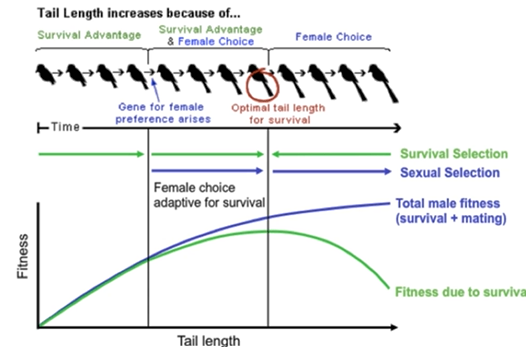
What are the female post-copulatory reproductive strategies?
post-copulatory choice → aka cryptic female choice
female’s chemical and physical mechanisms control male’s success of fertilizing an egg
choice is not cognitive but evolved
Give 3 examples of evidence of female choosiness
female chimps going on consortships with middle-low ranking males
female lemurs show more proceptive behaviors to newly integrated males (who are genetically diff so show they want genetic diversity)
female choice can also undermine male-male competition
females sometimes jump in a fight and support the male they choose
significantly influences male reproductive success independent of dominance
Explain infanticide as a male reproductive strategy
When a new male becomes alpha, he kills off all unweaned babies bc when a female is pregnant and lactating she cannot have kids and is therefore out of the mating pool. The new male wants to spread his genes to the next generation so he brings them back into sexual receptivity faster by infanticide.
ex) Geladas have a 2.5 year interbirth interval and the tenure of an alpha male is about 2-4 years so to make sure he has kids before leaving alpha status, he does infanticide to bring the females back to sexual receptivity
What are the 4 primate mating systems? Give an example for each of them
promiscuity - many to many
bonobos
polygamy - one to many
polygyny - 1 male, many females
orangutans
polyandry - 1 female, many males
marmosets and tamarins
monogamy - one to one
gibbons and siamangs
Give the example of alternative reproductive strategies in orangutans
2 distinct male morphs in orangutans - flanged and unflanged
they each have their distinct mating strategy
flanged males: call and wait
prefer females who have had children before
unflanged males: sneak and force
have offspring with first time mothers
flanged males may father more offspring but experience higher stress because they have to travel and sometimes have call battles with other orangutans
it has been seen that unflanged males become flanged and flanged become unflanged
Explain the evolution of same-sex behavior in primates
it was not studied for the longest time bc researchers considered it an exception but it has since been observed in over 1500 animal species
it is the norm not an exception
has been seen to increase oxytocin levels in bonobos more than hetero sex
current working theory is that it can be socially beneficial
Why do animals exhibit aggression and dominance?
status
food
mates
territory
protect kids
their own life
What are two main ways in which animals fight?
pure physical aggression → risky and can lead to very dangerous wounds
displays → costly from an energetic perspective but better way to show they are big and tough compared to getting hurt from pure physical aggression
stink fights → lemurs use stink fights
Give 4 ways in which animals can gain or exhibit dominance with examples
size - crayfish
inheritance - maternal rank inheritance for baboons
chemical - naked mole rats can suppress reproduction for nearby mole rats through pheromones
smarts - Mike the tin can pan
Explain the 2 major types of hierarchies and how they can be applied to individual and group dominance
Linear
very straight and linear line of dominance
individual/group A dominates B which dominates C
Nonlinear
One dominant individual/group but the rest are mostly equal
or can be circular
Individual/group A dominates B which dominates C which can also dominate A
What are the costs and benefits of high rank and of low rank?
High rank:
benefits: access to food and mates
costs: maintenance of ranks leads to high cortisol for some species
Low rank:
benefits: group living benefits, wait and see strategy (wait around and see, might get opportunity to achieve a high rank), relatively lower stress levels depending on species
costs: lack of access, aggression from other group members, high stress
Why do hierarchies often reduce aggression?
if hierarchy is stable and certain then everyone knows what their position is and they dont try to resettle it every day
often if hierarchy is overthrown or unstable, that is when most aggression is seen in primate groups
What is the definition of cooperation?
helping another individual (increasing their fitness) with no benefit or even at a cost to yourself
Explain cooperation through the theory of kin selection and define inclusive fitness and kin selection
direct fitness
parents help offspring bc their genes are directly getting passed on when their kids have kids
indirect fitness
help non-offspring kin bc they still are related to you and have some of your genes that can get passed on when they have kids
Inclusive fitness = direct + indirect fitness of an individual
Kin selection = evolutionary effect of helping relatives
ex) lionesses will nurse non-offspring kin
Explain Hamilton’s rule
predicted that altruism should evolve through kin selection if:
rB > C
r = coefficient of relatedness
B = benefits gained by recipients of altruistic act
C = costs to altruist in terms of future reproduction
basically says that the willingness to help depends on how related you are to the other individual and how much that will cost you
Explain cooperation for non-kin and give example of thought experiment about it
Hamilton’s rule doesnt apply to non kin but why has that still evolved
Reciprocal Altruism
helping nonkin someone in expectation that favor will be repaid in near future
Prisoner’s Dilemma
Explain the Prisoner’s Dilemma
in terms of evolution, the best choice would be for you to defect bc if you cooperate you are guaranteed prison time. the only possibility to get off completely scot free is if you deflect.
For one time interaction: ALWAYS deflect
think about the crappy tourist trap souvenirs you buy from vacation that break as soon as you get home → the ppl who sold it to you only see you once so there is no consequence to them that it broke
For repeated interactions: more cooperative even from non-kin
Tit-for-tat
if partner cooperates you do too, if partner deflects you do too
but if you buy something from your local store and it breaks, youre driving back there and getting a refund or smth so thats why for repeated interactions be more cooperative
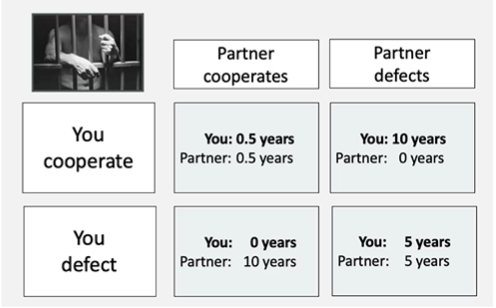
What are 3 conditions that must be met for reciprocal altruism to occur?
must have repeated interactions with those individuals
must have cognitive ability to keep track of altruists and cheaters
must have system in which altruists are rewarded and cheaters and punished
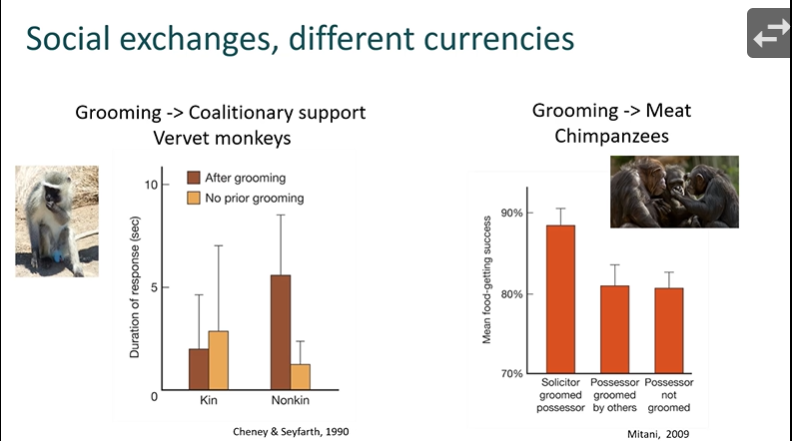
Explain what is happening in these graphs
social exchange has different currencies
on left, its seen that vervet monkeys jumped into help someone in a fight if they were kin and only jumped in for non-kin if that person had groomed them recently
on right, its seen that chimps will share meat with someone who groomed them
How to quantify social bonds in primates?
proximity
nearest neighbor
GROOMING
hygiene
social bonding
What are 4 types of bonds in social network analysis (SNA)?
degree = number of connections you have in a social network
strength = how tight that bond is
betweenness = how tightly is an individual connected to someone who isn’t connected to them
basically saying you are a connector bw two individuals
eigenvector centrality = you are only connected to one person but that person is connected to varying levels of connectedness to other ppl
“friends of friends”
6 degrees of separation type thing
How important are social bonds? Give 2 examples
very important for survival
study of white faced capuchins with the amount of grooming relationships actually predicts survival
also imp for reproduction
in chimps, the alpha male had access to females but those subordinate to alpha that were strongly bonded to him had higher reproductive success - short term access
AND subordinate males that had strong bonds with each other and not just alpha males had higher reproductive success as well bc it improved their rank - long term access
Explain the Amboseli baboon study and what they learned from it
often hard to study social bonding in primates bc you have to do super long term studies bc you cant figure out who is related to who w/o it and you cant ask them
so this is a long term study of Amboseli baboons - 40 yrs of research
Results
They found that there is high infant mortality
but baboon babies with highly socially integrated mothers have higher chance of survival
and baboon babies with high ranking mothers grow and mature faster
and being highly socially integrated is separate from being high ranking
also found that social bonds are critical in adulthood as well
adult females who were more socially connected lived longer
mother’s connectedness in early life linked to daughters’ survival